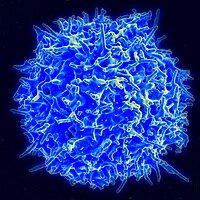
Photo from wikipedia
Preeclampsia (PE), new‐onset hypertension during pregnancy, is associated with a pro‐inflammatory state with activated T cells, cytolytic natural killer (NK) cells, dysregulated complement proteins, and B cells secreting agonistic autoantibodies… Click to show full abstract
Preeclampsia (PE), new‐onset hypertension during pregnancy, is associated with a pro‐inflammatory state with activated T cells, cytolytic natural killer (NK) cells, dysregulated complement proteins, and B cells secreting agonistic autoantibodies to the angiotensin II type‐1 receptor (AT1‐AA). The reduced uterine perfusion pressure (RUPP) model of placental ischemia recapitulates these features of PE. Blocking CD40L‐CD40 communication between T and B cells or B cell depletion with Rituximab prevents hypertension and AT1‐AA production in RUPP rats. This suggests that T cell‐dependent B cell activation contributes to the hypertension and AT1‐AA associated with PE. B2 cells maturing into antibody producing plasma cells are the product of T cell‐dependent B cell‐interactions and B cell Activating Factor (BAFF) is an integral cytokine in the development of B2 cells specifically. Thus, we hypothesize that BAFF blockade will selectively deplete B2 cells, therefore reducing blood pressure, AT1‐AA, activated NK Cells, and complement in the RUPP rat model of PE.
Journal Title: American Journal of Reproductive Immunology
Year Published: 2023
Link to full text (if available)
Share on Social Media: Sign Up to like & get
recommendations!